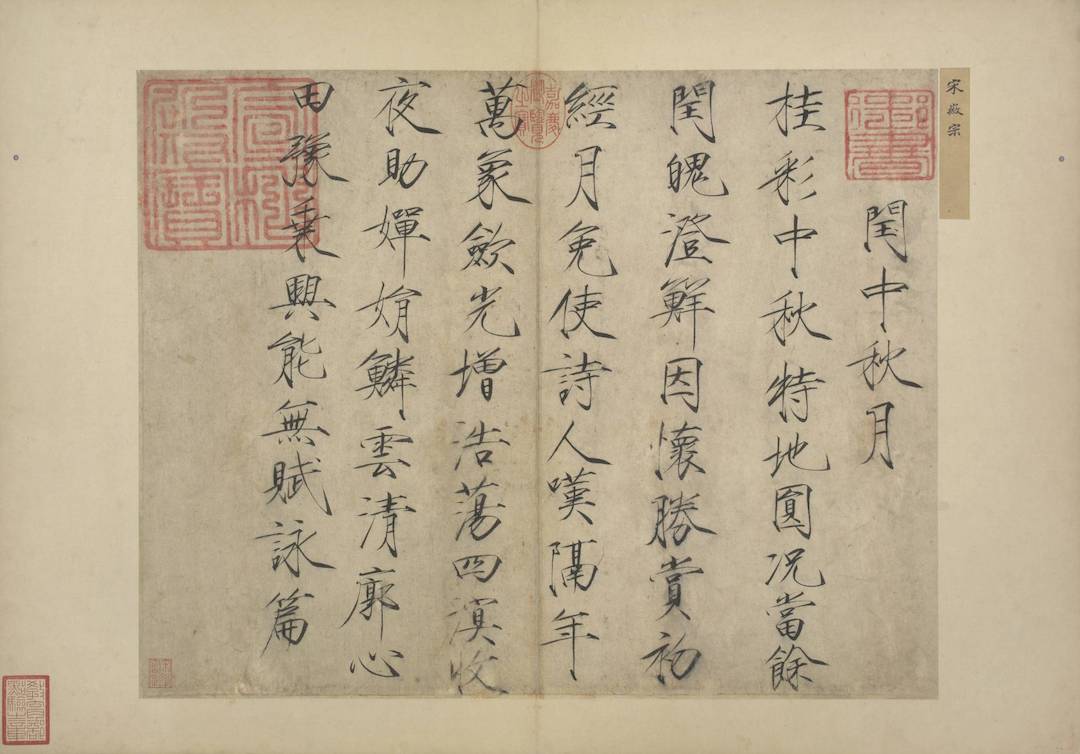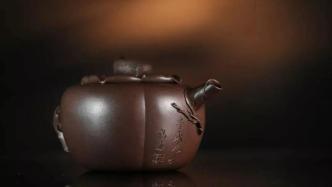
"The Classic of Tea" written by Lu Yu in the Tang Dynasty is the first monograph on tea science in the world. The "Tea Classic" was published, and the tea ceremony flourished. However, in today's society, how should we understand "The Classic of Tea"? "The Paper·Ancient Art" series of "Poems and Paintings about Tea" series, this issue interviewed Wang Jianrong, the former curator of the China Tea Museum and an expert in tea science.
"Tea has a saying that 'the tea ceremony is as simple as possible'. The tea ceremony cannot be performed, but the tea art can be performed. The tea ceremony is only a kind of understanding. The "Tea Classic" states that 'tea is used...the most appropriate practice is frugality. People', literati and scholars of the past dynasties endowed tea with so many connotations, but in the end it comes back to 'people' itself."
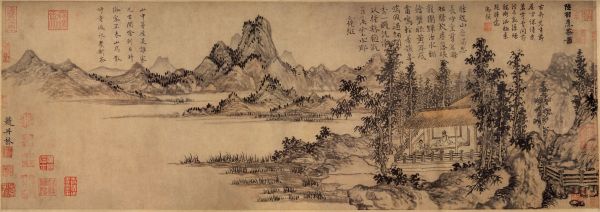
"Lu Yu Cooking Tea" by Yuan Zhaoyuan
"The Classic of Tea" is not long in length. The whole book is divided into three volumes and ten sections, with only more than 7,000 words, but every word is pearls. "The tea maker, the fine wood in the south, is one foot, two feet, or even tens of feet. There are two people hugging in the Bashan Gorge, and they cut it down..." Lu Yu started the chapter with the origin and appearance of tea, the most authentic Put the tea on full display. From the origin and current situation of tea trees to production technology; from the specifications of tea-making utensils to the standards of tea-making techniques; ", it can be called the encyclopedia of tea science.
This is a well-deserved research work on "the beginning of tea". Since then, there have been real "laws of tea", and tea has risen from "drinking" to "tasting". Both China and foreign countries are popular.
If you want to understand Lu Yu, you may start with a song "Six Envy Songs":
I don't envy the golden shackles,
I don't envy the white jade cup.
Don't envy entering the province,
Don't envy Mu on stage.
Thousands of people envy the West River water,
Once came down to Jingling City.
This "Song" was written by Lu Yu, recited by Lu Yu's disciples, and included in "Quan Tang Poetry". The beauty of the whole poem is that there is no word "tea", but Lu Yu's free and easy image of a tea man and his life experience are ready to come out.

"The Classic of Tea", engraved in Song Dynasty by Baichuan Xuehai, is the earliest extant engraved edition
Lu Yu (approximately 733-804) had a rough life experience. When he was three years old, he was abandoned in front of Longgai Temple in Jingling, Hubei (now Tianmen, Hubei). Zen master Zhiji in the temple adopted him. Tea is closely related to Buddhism, because tea can refresh the mind and facilitate Zen meditation. Since the Wei and Jin Dynasties, it has been popular to plant tea trees in temples and drink them by themselves. The trend of drinking tea also originated from temples. Since Xiao Lu Yu was young, he often served his master to drink tea, so he has a deep understanding of tea.
Although he was older than Buddhism, Lu Yu admired Confucianism more. Lu Yu, a young man, was unwilling to convert to Buddhism. After leaving the monastery, he joined a theater troupe. When Lu Yu was in the opera troupe, he was able to make friends with local officials and literati, tasted tea with them, talked freely about poetry, and studied under Master Zou, a Confucian scholar who lived in seclusion in Jingling. After the "Anshi Rebellion" broke out, Lu Yu left Jingling and traveled all over the middle and lower reaches of the Yangtze River and the Huaihe River Basin. Rich experience in appreciating water and tasting tea.

Wen Zhengming's "Zhenshangzhai Picture" depicts the scene of literati tasting tea in the mountains and forests
The contacts with literati and hermits also had a profound impact on Lu Yu's thoughts. During his travels in Zhejiang, Lu Yu also met Jiaoran, a poet monk. Jiaoran's secular surname is Xie, and he is the tenth grandson of Xie Lingyun. He was ordained as a monk at Lingyin Temple in Hangzhou. Jiaoran not only has extremely high attainments in Buddhism, but also has a high level of literary accomplishment, and is very fond of tea, and has a good relationship with Lu Yu. Among the more than 400 poems written by Jiaoran in his life, quite a few of them are about tea. In the early years of Shangyuan (760) in the Tang Dynasty, with the help of Jiaoran, Lu Yu lived in seclusion in Tiaoxi (now Huzhou, Zhejiang) and wrote the first draft of "The Classic of Tea". In 780 AD, the "Tea Classic" began to be published.
Lu Yu never envied power and wealth all his life. Emperor Tang cherished Lu Yu's talent and worshiped Lu Yu twice as "Prince Taixue" and "Taichang Temple Taizhu".
Although the "Tea Classic" has been written for more than 1,200 years, and the way of drinking tea and the tea making process have undergone great changes compared with the Tang Dynasty, Lu Yu has precise views on the history, origin, efficacy, and artistic aesthetics of tea. Be sure, these expositions have not lost their reference value so far.
To this day, there are still countless tea lovers and tea lovers who are tasting and reading "The Classic of Tea". Wang Jianrong, the former curator of the China Tea Museum, believes that even though Lu Yu's era is far apart, the tea ceremony norms he established and the spirit of tea people he advocated have always influenced the latecomers.
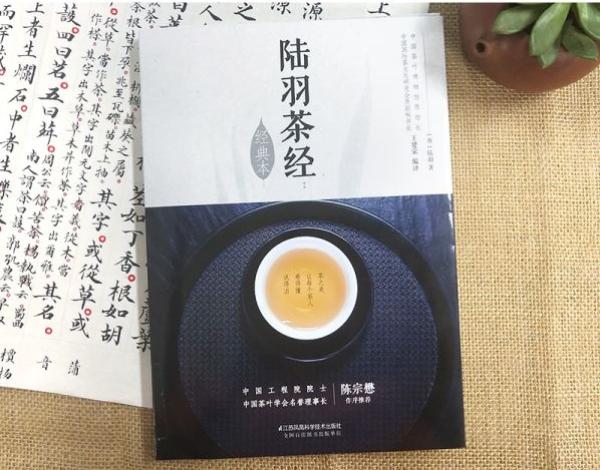
Wang Jianrong's "Lu Yu's Tea Classic: The Classic Edition"
Wang Jianrong introduced to The Paper: "Lu Yu not only advocated 'fine practice and frugality', but also described a fire-making utensil 'blast stove' in the 'Four Vessels' of the "Tea Classics". The meaning of two levels, one foot cloud "Sunda on the top of the Kan and Li in the middle", is to make good tea by using the gossip skillfully; "Tang Mie Hu Ning Ming Zhu' is the expectation of social stability. Whether it is tea itself or the social value of tea, Lu Yu has given a high sense of social responsibility."
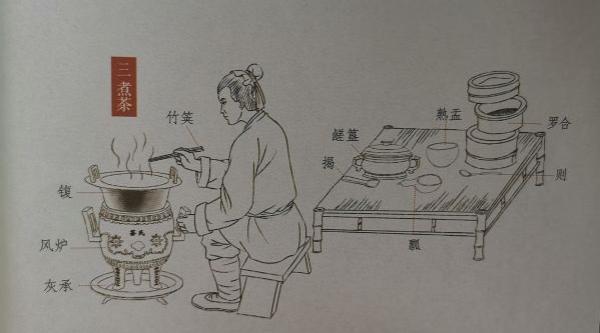
Schematic diagram of brewing tea in a wind stove, the picture comes from "Lu Yu's Tea Classic: Classic Edition"
"In addition, people today can still get new inspiration from the "Tea Classic", which is the reason why this Tang Dynasty classic is still shining today." Wang Jianrong, who was born in a tea science class, has worked in the museum for decades. Winner of the "Lu Yu Award", has a solid foundation in tea science, and has authored many books related to tea and tea science, such as "Lu Yu's Tea Classic: The Classic Version", "<Daguan Tea Theory> Searching for Tea and Asking Questions".
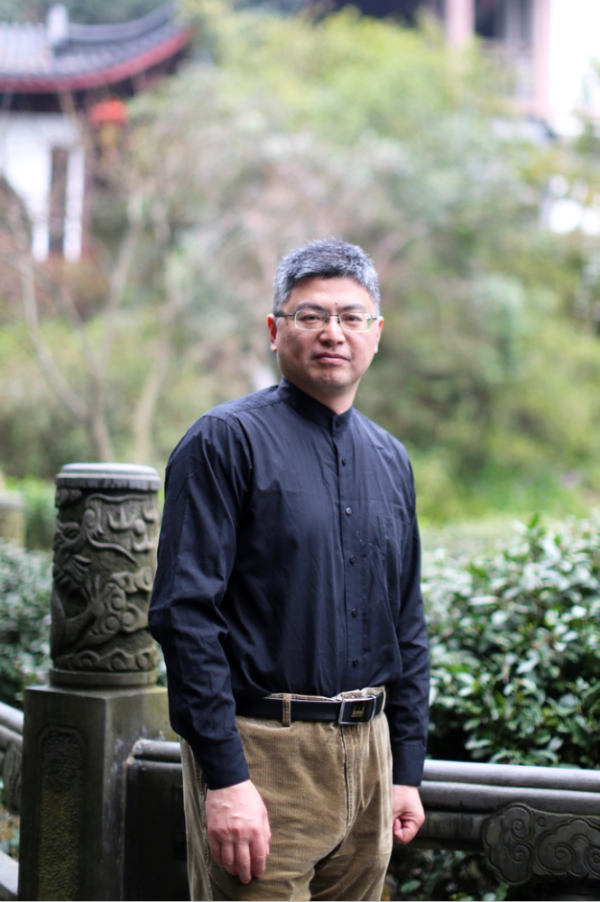
Wang Jianrong, former curator of China Tea Museum
Dialogue|Wang Jianrong: "The Tea Ceremony to Simplicity" is the realm pursued by tea people
The Paper: Lu Yu is a very individual person. From the fact that he named his tea book "Jing", it can be seen that he has great ambitions for his own knowledge, and later generations also honored Lu Yu as the "Tea Saint". How would you rate The Classic of Tea? What influence does The Classic of Tea have on the development of Chinese tea culture?
Wang Jianrong: I don't think the "Tea Classic" can be positioned too much. It is the first tea book in the world, and it is also a book of masters.
The contribution of "The Classic of Tea" is mainly in two aspects. One is that Lu Yu sorted out all the summaries about tea from before Tang Dynasty to the middle Tang Dynasty. He carried out standardized and systematic sorting and established the tea ceremony system, which is very important. , that is to say, it has established the development path of the general outline of tea science.
The second is the impact on later generations. It is precisely because he created a complete system of tea ceremony, which deeply influenced people's understanding of tea after the middle Tang Dynasty, and even to the present. He is both a master and a trailblazer. After the publication of The Classic of Tea, there have been more than 60 different versions in the past dynasties. It is only after the establishment of the system that people are willing to promote and pass it on. Moreover, "The Classic of Tea" has been widely disseminated around the world, and there are versions in different languages all over the world.
The Paper: In terms of professional content, what touched you the most in The Classic of Tea?
Wang Jianrong: It is systematic and professional. The three volumes and ten sections of "The Classic of Tea" are highly logical and systematic, covering all aspects of tea in a very orderly manner.
The second point is that Lu Yu has a deep understanding of tea. For example, in the "Two Tools" in the book, Lu Yu listed nineteen tools for picking and making tea; The description of the eight grades of tea; the "Four Vessels" describe in detail the twenty-four utensils for drinking, brewing and tasting tea. These detailed contents can make readers feel that Lu Yu has a deep understanding of tea.
Third, the "Tea Classic" also reflects the idea of adapting measures to local conditions. For example, in the "Nine Strategies", it talks about which way to drink tea under what kind of environment. Although tea drinking needs to be particular, it can be adjusted according to the situation, and some "exquisiteness" can be discarded according to different situations. The tea-drinking life advocated by Lu Yu is not rigid, but can be adjusted randomly.
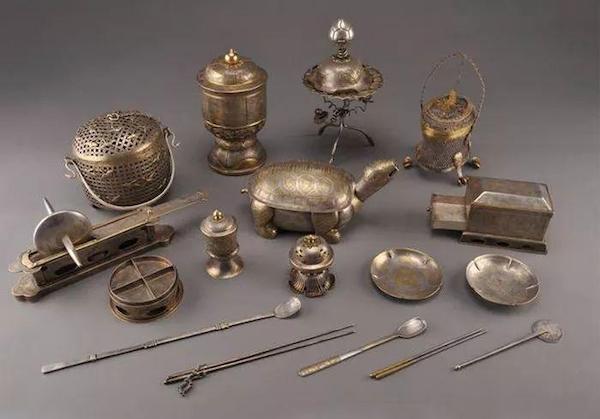
Tang court tea set unearthed from the underground palace of Famen Temple
The Paper: In "Nine Strategies", Lu Yu talked about how to pick in Yesi Mountain Garden, how to choose utensils on the pine rocks, and some tools can be discarded if you look at the spring and the stream. Very instructive and elegant.
Wang Jianrong: That's right, Lu Yu also said, if you are in a noble family in a city, if one of the twenty-four utensils is missing, the tea will be useless. So from it, we can not only see the tea-drinking customs of those elegant people who live by the streams in the forest, but also see Lu Yu's standardization of tea-drinking.
Moreover, in the "Picture of Ten", Lu Yu advocated that the "Tea Classic" should be written on silk and hung for display. Tea is no longer a cup of tea, but your whole room and your heart should be soaked in tea all the time. Witnessing and Taoism, Lu Yu advocated the promotion of tea ceremony through these methods. So I think "The Classic of Tea" is still a classic.
The Paper: What kind of appearance and personality does Lu Yu himself have?
Wang Jianrong: Lu Yu has an autobiography "The Autobiography of Lu Literature", writing that he "has the ugly appearance of Zhongxuan and Meng Yang, and the stammer of Xiangru and Ziyun". Zhongxuan and Meng Yang are ugly men in history, and Lu Yu's appearance Clearly poor and stuttering. But Lu Yu was humorous and witty, arguing for talents, so when he was in the theater troupe, he was also appreciated by Li Qiwu, the prefect of Jingling, and had a good relationship with Cui Guofu, a doctor in the Ministry of Rites who was demoted to Jingling at that time, and they shared the same goals.
It is also written in the autobiography, "Whenever I have a banquet with others, I feel comfortable, and I leave without saying a word. People may doubt it, which means that they are angry. I also believe in people, and I will go through thousands of miles of ice and snow. Tigers and wolves rule the way, and there will be no mistakes." It can be seen that his personality is straightforward and he keeps promises.
The Paper: When he wrote "The Classic of Tea", what was the society's attitude and state towards tea at that time?
Wang Jianrong: The custom of drinking tea in the Tang Dynasty was already very common. Lu Yu just saw all kinds of bad or irregular ways of drinking tea, so he wanted to establish and form a standardized and healthy way to improve the overall People's understanding of tea.
This can also understand why he wrote the "Book of Tea" in a very scientific way. The twenty-four utensils and nineteen tea-picking tools all have precise dimensions, including the growth conditions of the tea and the identification of the grade of the tea. , and even the origin of tea culture, historical legends, etc., he gave a detailed explanation.

Qing Jin Tingbiao "Pin Quan Tu" Collection of Taipei National Palace Museum
The Paper: The "Tea Classic" states that "tea is for use... the most suitable for those who are frugal and virtuous". Why did Lu Yu say that? How do we understand tea virtue?
Wang Jianrong: Generally speaking, tea virtue is the spirit and character of tea. Lu Yu's understanding of the virtues of tea is "fine practice and thrifty virtue". It is reflected in two aspects. One is that doing things requires precision, that is, we must strive for perfection; the other is that we must have the virtue of thrift in life.
Lu Yu would put forward this idea, which is related to his experience. Lu Yu was born in 733 AD and died in 804 AD. He experienced the process from the prosperity of Kaiyuan to the Anshi Rebellion. The Anshi Rebellion was the turning point of the Tang Dynasty from prosperity to decline, and it was also because of the Anshi Rebellion that Lu Yu came to Jiangnan. He saw the political turmoil and social turmoil brought about by the court's transition from frugality to extravagance, so he hoped to use tea virtue to arouse people's awareness, and through the prosperity of tea ceremony, the society could be peaceful.
The Paper: Your "Lu Yu Tea Classic: Classic Edition" is also loved by many tea lovers. What is the opportunity for you to write this book?
Wang Jianrong: My undergraduate major is tea science, and my postgraduate major is museum major. These two majors were selected into the top ten unpopular majors in the 1990s. When I was the curator of the China Tea Museum, I asked the lecturers in the museum to recite the "One Source" and "Six Drinks" of the "Tea Classic". The premise of reciting is understanding. At that time, I found more than 20 editions of books on the interpretation of "The Classic of Tea".
There are more than 60 editions of "The Classic of Tea". I chose the Southern Song Baichuan Xuehai edition of the National Library of China for research, collation and sentence reading. I also modified more than 70 places in Baichuan Xuehai, and made some interpretations of the changes from ancient to modern times. In addition, in order to make it easier for everyone to understand, the teachers of the Academy of Fine Arts are also invited to describe the utensils and scenes involved in "The Classic of Tea".
At that time, I thought that such a professional book would have a relatively small audience, but surprisingly, this interpretation has been reprinted, and now it is the nineteenth printing.

Wang Jianrong (the second from the left in the back row) inspected Chashan with colleagues and students
The Paper: Can you tell us some of your different interpretations of The Classic of Tea?
Wang Jianrong: For example, Lu Yu said, "Don't eat it when the waterfall is turbulent. If you eat it for a long time, you will have neck problems." Literally, Lu Yu said that fast-flowing water should not be drunk, and it is easy to get neck-related diseases. Many versions are also interpreted in this way. I consulted a professor of traditional Chinese medicine. The "neck" in Chinese medicine also means "path", which means rapid infectivity, that is to say, the rapid flow of water will bring viruses and bacteria, and it is easy for people to suffer from acute infection. sick.
In the chapter on tea picking, Lu Yu also mentioned "Ling dew picking Yan", not picking tea while taking advantage of the dew, but saying that there is a high probability of sunny days in spring when there is dew in the early morning. If you wake up in the morning and see dew in the early morning, then Today is a sunny day, which means picking tea on a sunny day. This is still the case now, the quality of tea picked on sunny days is better.
For another example, Lu Yu mentioned in "Shen Yi Ji" "Yu Hong, a native of Yuyao, went to the mountains to pick tea, met a Taoist priest, and led three green cattle". Many people interpreted it as leading three green cattle, but in fact "three green" is a Taoist One of the colors is not three blue cows, but one three blue cows.
The Paper: The current way of drinking tea and the types of tea are completely different from those in Tang and Song Dynasties. What is the significance of reading "The Classic of Tea" now?
Wang Jianrong: There are still many tea lovers who recite the "Tea Classic" repeatedly, and I often organize everyone to study. If you can truly understand the "Tea Classics", you will be able to understand which things have remained unchanged for thousands of years, which things have changed, and why they have changed, so that the past can be used for the present.
Tu Youyou won the Nobel Prize for extracting artemisinin, and she was also inspired by a few words in ancient books. In "Elbow Reserve Emergency Prescription", it says, "When you hold Artemisia annua, soak it in two liters of water, twist it to get the juice, and take it as much as you want. It is necessary to extract artemisinin under cooling, and high temperature will affect the active ingredients and affect the curative effect, so the extraction with ethanol is changed to extraction with ether, which has a lower boiling point than ethanol. I think that whether we are pursuing the intangible cultural heritage of tea or the improvement of the technology, in all aspects of tea, many contents of the "Tea Classic" are worth pursuing now. Perhaps Lu Yu's few words can bring innovation to the inheritance of tea Come to unexpected value and effect.

Song Huizong (style) "Wen Hui Tu" (axis) Collection of the National Palace Museum, Taipei
The Paper: What were the tea parties and elegant gatherings of the ancients like?
Wang Jianrong: According to some poems in the Tang Dynasty, a tea party is basically a gathering of some literati, reciting poems and singing together, accompanied by tea.
Some paintings of Tang and Song gatherings have such descriptions, such as "The Picture of the West Garden", "Wenhui Picture" by Song Huizong, Wen Zhengming's "Huishan Tea Party Picture" and so on. There can be tea, wine, poems, books, paintings, and exchanges between literati in pavilions, towers, pavilions, or beside streams and streams in mountains and forests.
The Paper: In addition to serving tea as a drink, literati of all ages have also endowed tea with many aesthetic connotations. How do we understand the beauty of tea?
Wang Jianrong: The beauty of tea can be understood from two levels, one is the material level and the other is the spiritual level.
Tea can be "firewood, rice, oil, salt, soy sauce, vinegar tea" in daily life, or "qinqi, calligraphy, painting, poetry, wine and tea" in spiritual life. The ancients said that "technique is close to art, and art is close to Tao". From tea technique to tea art, and then to tea ceremony, tea lovers can first learn some basic skills. From the perspective of drinking, know how to choose the right water and how to adapt it Utensils and how to brew tea soup are all knowledge.
Then you can do some artistic practice. In addition to tea art, there are many tea-related music, calligraphy, and painting arts; the last is to understand the tea ceremony. Different comprehension abilities will give you different feelings, which is at the philosophical level. .

"Mr. Twelve Tea Sets" in "Pictures of Tea Sets"
The Paper: With the re-prosperity of tea culture, there are now many restorations of Tang and Song tea art performances. What do you think of these performances?
Wang Jianrong: It is actually quite difficult to restore the Tang and Song tea art performances. The first thing is that the utensils must be in place. A set of royal court tea sets from the Tang Xizong era was unearthed from the underground palace of Famen Temple in Fufeng, Shaanxi, including tea cages, wind stoves, tea bags, tea mills, tea boxes, etc. This set of tea sets is made of silver and gilt; The fourteen utensils are a very clear set of utensils that can show the literati tea in the Tang Dynasty.
In the Song Dynasty, there was "Tea Set Illustrated" written by the old man Shen'an. This is the first monograph in my country to write about tea in the form of a map. He used the line drawing method to draw twelve tea sets used in tea fighting in the Song Dynasty. These twelve tea sets are also called "Twelve Gentlemen". But it is a little regretful that "Mr. Twelve" only has a picture and no size, so the imitation will be out of proportion now.
What is even more difficult is the tea product, which is to make tea completely according to the processing technology of Tang and Song Dynasties. Although there are very clear historical records, there are very few teas that can really be made according to the tea making technology of Tang and Song Dynasties. There is also a process problem, because the tea is not right, and there will inevitably be deviations in the demonstration. Considering the matching music and costumes, so far there is no Tang and Song tea art restoration that I am particularly satisfied with.
But from the perspective of cultural promotion and promotion, I think there can be some deductive elements in it, which can inspire everyone to explore the tea culture of Tang and Song Dynasties and love tea, which is worth encouraging.
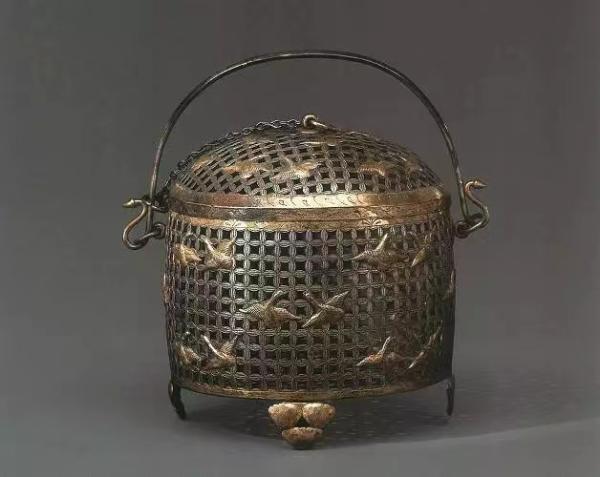
Tang court tea set unearthed from the underground palace of Famen Temple
The Paper: Tea art is very complicated, and there is a saying that "the tea ceremony is as simple as possible". The Japanese tea ceremony master Sen Rikyu once said, "You must know that the essence of tea is to boil water and order tea." How to understand tea art and tea ceremony?
Wang Jianrong: Any of our externalized and complicated forms of tea art to render tea drinking is nothing more than making tea bring health and pleasure to the body and spirit.
What do we learn about tea? In fact, I learned some basic skills, then learned some methods, and finally let tea open your five senses and integrate with people, which is our traditional philosophy of "harmony between man and nature".
Now many people promote "tea ceremony performance", but I don't agree with it, the tea ceremony cannot be performed, what can be performed is the tea ceremony. The tea ceremony is just a kind of comprehension. What Sen Rikyu said is correct. We can order tea by boiling water very concisely and feel the spiritual pleasure brought by tea. "The tea ceremony is as simple as possible" is a kind of state that we tea people pursue.
I often say that there are two cups of tea in life, one cup of healthy tea and one cup of happy tea. Tea is both vulgar and elegant. Lu Tong, a poet of the Tang Dynasty, wrote that "one bowl of tea moistens the throat, two bowls break the loneliness and boredom. Three bowls are exhausted, but there are only five thousand volumes of words. Four bowls of tea sweat lightly, and all the injustices of life are scattered to the pores. Five bowls Muscle and bones are clear, six bowls of Tongxianling. Seven bowls can't be eaten, but the two armpits feel the breeze." This is the sublimation from material to spiritual, and literati endow tea with so many connotations, and finally return to "human" In itself, let us drink healthy tea, happy tea.

Selection of Yuan Qian "Lu Tong Cooking Tea" Collection of the National Palace Museum, Taipei
The Paper: Nowadays, many people advocate drinking tea according to the twenty-four solar terms. How do you understand the relationship between drinking tea, timing and solar terms?
Wang Jianrong: I think it may be more appropriate to drink tea according to the four seasons. The four seasons reincarnate, and people and nature are in harmony. Drink some tea that is more suitable for your physical condition in different seasons. According to the twenty-four solar terms, it is too extreme, and it is difficult for everyone to be so particular and grasping.
How to choose the topic of tea, there are two prerequisites, the first is to understand your own physique, everyone’s physique is different, so the choice is naturally different; the second is to understand the nature of tea; the third is the situation, which includes spring, summer, autumn and winter , including men, women and children, including before and after meals, as well as health or illness. So how to choose tea can not have a standard answer.
If you don’t know much about it, you can drink a certain kind of tea for a week and feel comfortable that it is suitable for you.
